
The Serious Freshening
Go to <Last, Summary, Next>Exterior—Rear Hatch Latch
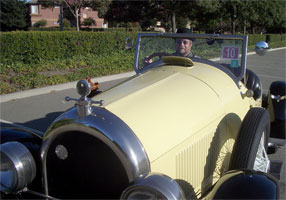 Lynn in Bugsby, September 5, 2005 |
Completed: 2007-02-05 — Started: 2007-01-31
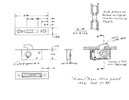 |
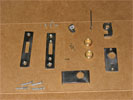 |
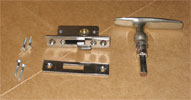 |
| HATCH LATCH: In October, 2006, Joe Leaf sends a sketch (left) of the latch on the hatch of his 1922 Kissel 6-45 Speedster. Using this design as a rough guide, Lynn builds a latch (center, right) for Bugsby. Lynn did not fabricate the handle shown in the photo on the right. |
Work Completed:
The restoration efforts on the refinish of Bugsby's body have been stalled for a couple of months.
The problem is finding a suitable latch for the new hatch that's been built by
Kevin Schell.
Lynn has failed in his attempts to find a suitable latch even after many weeks of internet searches.
Kevin cannot complete the body work until a solution to the hatch latch is found.
In October, 2006, Lynn writes to several other Kissel Speedster owners asking for suggestions of a source of appropriate hardware. In response to his call for help, Joe Leaf sends a detailed drawing of the latch on his 1922 Speedster.
The design looks simple enough on paper and Kevin agrees to attempt to build one in his shop. Unfortunately, weeks then months pass and Kevin doesn't find the time to make serious progress on the latch. Eventually Lynn realizes that he must take responsibility for this item to get the project unstuck.
Loosely following the design in Joe's sketch, Lynn attempts to build a latch in his garage using cold rolled steel bars (of three different thicknesses) and a 3/8"x2" brass nipple that he purchases at a local hardware store. A hack saw is used to cut the metal pieces, and the metal is shaped with metal files. He uses a bench vise and hammer as a metal break to bend the parts for the box. A jewelers lathe turns the brass nipple into two bearings and cuts a groove for these bearings in the toggle. He uses a bench grinder with a wire wheel and cotton buffing wheel to polish the final pieces, coating the parts with a fine clear lacquer.
The latch in Joe's sketch uses a flat piece of spring steel to hold the toggle in the open or closed position. Unable to locate suitable material, Lynn creates a spring from a large metal pin. Initially this solution doesn't provide enough tension on the toggle, so Lynn adds a coil spring assist. With the added tension, the assembled lock has a satisfying snap as it moves to the fully open or closed position. With a few drops of All-In-One oil, the assembled latch operates smooth as silk.
Lynn uses five #4-40 flat-head machine screws to hold the mechanism together. Unfortunately these screws have Phillips-drive heads, the only small fasteners that he has on hand. Phillips-drive screws are also the only ones he can purchase in local hardware stores these days. This is a problem as the Phillips drive was not invented until the early 1930's, first used by General Motors on the 1936 Cadillac, and fully adopted by most American automakers by 1940. As a result, these fasteners are not appropriate for use on a 1924 car that has pretensions of being historically accurate. Lynn places an order for about $50 of assorted slot-drive machine screws from Restoration Supply Company and will replace the anachronistic fasteners within days.
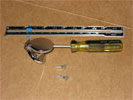 |
|
This small spring loaded cap (for a Trimuph TR3?) is thought to be very similar to that
originally used by Kissel to cover the latch access hole. |
At the Kissel 100-year anniversary celebration, Joe Leaf and Lynn talk about his need for a cover for the access hole for the rear deck latch. Joe tells of his efforts to create new castings of the original Kissel design. Lynn mentions that he has seen notations on some drawings for the hatch that the latch cover was like that on a more modern Triumph TR3. To Lynn's utter amazement Joe pulls such a cover from his pocket and makes a gift of it to Lynn, further putting Lynn in Joe's debt. If it were nickel plated, instead of chrome plated, Lynn thinks that virtually no one would question it's authenticity. For now, Lynn plans to use it "as is" with the idea of getting it nickel plated some time in the indefinite future.
 |
|
Some of the scrap that Lynn generates as he iterates toward his a final latch design. |
The final latch shown in the photos at the top of this section is the result of multiple attempts that were reluctantly discarded after fatal flaws in the design was discovered, or the quality of the workmanship was found to be lacking. The final latch that Lynn builds is actually larger by about 1/4" in all dimensions than the one shown in Joe's sketch. Lynn finds that he needs the extra size to ease interference with the moving parts. He is impressed with the elegance of the original design and surprised how hard it is for him to duplicate. After many hours of hand work, Lynn gains new insight to, and appreciation for the craftsmanship that the original design represents.
In the end, Lynn is very satisfied with his creation. He gets additional pleasure when he presents the latch to Kevin and Kevin approvingly operates the lock with the tee handle, commenting on the perceptible snap of the lock into the open and closed positions.
Work Remaining:
None.
Contact
 with your comments or questions
with your comments or questionsCopyright © 2018 Lynn Kissel
Last updated: May 24, 2009